Lab 8. Fossils of the Mesozoic
Printer-friendly worksheets for Lab 8
Note: For this lab, questions are interspersed within the text of the lab rather than separated into Exercise sections. Use the worksheets to make sure you have answered all of the questions.
Time Interval

Goals
By the end of this lab you will:
- Understand the preservation bias in the fossil record and how that can affect the interpretation of ecological communities.
- Know the defining characteristics of the major plants and animals in Kingdom Protista.
- Be able to identify all the major marine phyla in Kingdom Animalia.
Introduction
In Lab 5, you learned that the probability of fossil preservation is greater for organisms that have hard parts (such as shells, exoskeletons, spines or bones) that are buried rapidly or end up in anoxic environments. This lab will begin with an introduction to the causes and challenges of preservation bias in the fossil record.
Lab 6 introduced some of the unicellular organisms that were the simplest forms of life during the Precambrian. Because many new forms emerged during the Mesozoic era, in this lab we shall return to these unicellular organisms in Kingdom Protista. We shall then examine orders within Class Cephalopoda, which arose during the Cambrian alongside the other classes of Phylum Mollusca but became important as guide fossils during the Mesozoic. The last phylum of Kingdom Animalia that you will learn about, the echinoderms, will then be introduced. This phylum arose during the Paleozoic but increased in variety and number in the Mesozoic.
